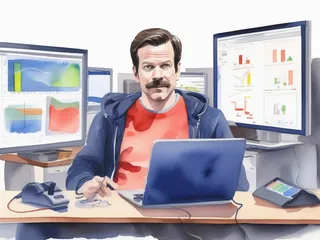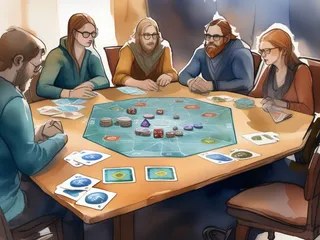Joining an existing team as a new Scrum Master is like being dropped into the middle of a complex ecosystem with its own established patterns and invisible rules. You might be tempted to immediately start "fixing" things based on textbook Scrum implementations or previous experiences. Don't. Instead, invest time understanding the current landscape before making any changes. These teams have history, context, and reasons (good or otherwise) for how they operate. Your first job isn't to change—it's to comprehend.
Understanding the Product
1. What problem does your product solve?
This seemingly basic question often reveals fascinating insights about how different team members perceive their work. I've sat in rooms where developers, product owners, and designers each offered completely different answers. These variances aren't just interesting—they're critical warning signs of potential misalignment. The answer shouldn't just match the company website; it should be consistently understood across the entire delivery team.
2. Who are your primary users?
The team's understanding of their users reveals volumes about their product thinking maturity. Watch for answers that go beyond demographics into genuine user needs and pain points. Teams that struggle here might benefit from more exposure to real users through demos, interviews, or usability sessions. I've found that teams who can vividly describe their users tend to make more intuitive product decisions.
3. What are your high-level objectives?
This question cuts to the heart of purpose and direction. Look for clarity and consistency across team members—do they all articulate the same north star? If you get vague, conflicting, or purely technical responses, the team might be disconnected from the business strategy. Great teams can draw a clear line from their daily work to meaningful outcomes for users and the business.
4. Is there an established roadmap?
The response here tells you about planning horizons, alignment with business goals, and how the team handles uncertainty. I'm not just looking for whether a roadmap exists, but how it's used—is it a communication tool or a commitment contract? Is it flexible and outcome-based, or rigid and focused solely on features? How often it changes speaks volumes about the organization's planning maturity.
5. How do you organize the backlog?
Backlog structure reveals the team's prioritization approach and how they connect tactical work to strategic objectives. Look for signals about how they handle technical debt, bugs, and feature work. Teams with well-organized backlogs typically use some form of hierarchical structuring (epics, stories, tasks) and clear labeling that enables them to balance different work types. The backlog is the team's primary steering mechanism—its organization matters tremendously.
Stakeholder Management
6. Who are your key stakeholders?
This question maps the team's political landscape. Beyond identifying names and titles, listen for how the team characterizes these relationships. Do they view stakeholders as allies or obstacles? The answers often highlight power dynamics that might not appear on any org chart but significantly impact how work flows through the system.
7. How do you engage with them?
Engagement patterns reveal communication rituals and influence channels. Look for regular, structured touchpoints versus reactive, emergency-driven interactions. Healthy stakeholder relationships typically involve proactive updates, expectation setting, and joint problem-solving rather than status reporting and approval-seeking. I've seen teams transform their delivery capability simply by changing their stakeholder engagement model.
8. How do you collect feedback?
Feedback mechanisms demonstrate the team's learning orientation. Strong teams have multiple feedback loops at different time scales—from sprint reviews to user testing to analytics. Listen for whether feedback is treated as a gift or a threat, and whether it comes from diverse sources or just the loudest voices. The sophistication of a team's feedback collection often predicts their ability to adapt and improve.
9. How do you make final decisions?
Decision-making processes expose power structures and how conflicts get resolved. Is it consensus-driven, consultative, or command-and-control? Are decisions documented and communicated? Some of the most dysfunctional teams I've worked with had unclear decision rights that led to either paralysis or shadow decisions that weren't truly supported. Clear decision frameworks accelerate delivery while building trust.
10. What are their main concerns?
Understanding stakeholder anxieties provides essential context for how you'll need to manage expectations. Do they worry about deadlines, quality, scope, or business outcomes? Their concerns often reveal past problems and organizational scars. By knowing what keeps stakeholders up at night, you can tailor your communication to address these specific fears and gradually build confidence in the team's delivery approach.
Team Dynamics
11. What are the team's core strengths?
Every team has superpowers—special capabilities they bring to challenges. Some teams excel at technical problem-solving, others at user experience design, still others at working through ambiguity. Identifying these strengths helps you understand where the team naturally shines and where they might need support. More importantly, explicitly recognizing strengths builds confidence and identity that carries teams through difficult periods.
12. Is the team truly cross-functional?
This question examines whether the team has all the skills needed to deliver end-to-end value. Beyond just having diverse roles represented, true cross-functionality means minimal dependencies on external teams or specialists. Watch for bottlenecks in the delivery process that might indicate missing capabilities. I've worked with supposedly cross-functional teams that were missing crucial skills in testing, UX, or operations that severely limited their autonomy.
13. How does the team collaborate?
Collaboration patterns reveal how knowledge flows between team members. Do they pair program? Conduct design reviews? Have technical discussions at the whiteboard? Strong teams have multiple modes of collaboration that fit different problems—structured for complex decisions, fluid for creative work. The physical (or virtual) workspace often reflects these patterns, with effective teams creating environments that enable their preferred collaboration styles.
14. Are there unspoken expectations?
Every team operates with implicit rules that rarely appear in any documentation. These might involve when people are expected to be available, how conflicts are addressed, or even how much polish is expected in deliverables. Uncovering these hidden expectations early helps you avoid inadvertent norm violations. I've found that asking about "how things really work around here" often surfaces crucial context that would otherwise take months to discover.
15. How is feedback exchanged?
The feedback culture determines how quickly teams learn and adapt. Does feedback flow freely in all directions? Is it timely and specific? Do people receive it as a gift rather than criticism? Teams with healthy feedback mechanisms typically demonstrate greater psychological safety and continuous improvement capability. Watch especially for whether the most junior members feel comfortable providing feedback to more senior colleagues—this is often the true test of feedback culture.
Process & Performance
16. What's your Definition of Done?
This core Scrum artifact reveals quality standards and delivery expectations. Beyond the formal checklist, listen for how consistently it's applied and whether it represents a meaningful quality bar. The best Definitions of Done evolve over time, incorporating lessons learned and raising standards as the team matures. Pay attention to whether the definition addresses technical excellence, not just functional completeness.
17. How often is the backlog refined?
Refinement practices indicate how the team handles upcoming work and manages dependencies. Effective teams treat refinement as an ongoing process rather than a single meeting, with appropriate detail levels for different time horizons. The cadence and participation patterns in refinement sessions often predict how smoothly sprint planning and execution will go. Look for signs that the team genuinely understands upcoming work before committing to it.
18. What KPIs do you track?
Metrics reveal what the team values and how they measure success. Are they focused on output (story points, velocity) or outcomes (user engagement, business results)? Do the metrics drive behavior change or just create reports? The most effective teams use a balanced set of metrics that connect daily activities to meaningful outcomes. Be especially wary if the team tracks nothing or if metrics are imposed without connection to team learning.
19. How do you define success?
Beyond formal metrics, understanding how the team conceptualizes success provides insight into their values and mindset. Is success about meeting deadlines, delighting users, or building maintainable systems? The best definitions span multiple dimensions and balance short-term delivery with long-term sustainability. This question often reveals misalignments between different team members that might explain tensions or conflicting priorities.
20. What recurring obstacles exist?
Every team faces systemic impediments that limit their effectiveness. Some teams have dependency bottlenecks, others struggle with technical debt, still others face organizational policy constraints. Understanding these recurring challenges helps you focus your improvement efforts where they'll have the greatest impact. Listen for patterns across responses and note which obstacles generate the most emotional energy—these are likely the most significant limiters.
Working Together
21. How accessible are you?
This question explores communication expectations and boundaries. Do team members prefer scheduled meetings or ad-hoc conversations? Are they comfortable with interruptions or do they need focused time? Do they work non-standard hours? Understanding these preferences helps you establish productive working relationships without inadvertently creating stress. I've found that explicitly discussing accessibility expectations prevents many common team frictions.
22. How should we handle conflicts?
Conflict resolution approaches vary dramatically between teams and individuals. Some prefer direct confrontation, others need time to process before discussing issues. Some want a mediator present, others find that intrusive. By understanding preferred conflict styles early, you can help facilitate resolution in ways that respect team members' needs. This question also signals your recognition that conflict is normal and can be healthy when handled well.
23. What support do you need most?
Different team members need different types of assistance from a Scrum Master. Some need help removing external impediments, others want coaching on agile practices, still others benefit most from facilitation of difficult conversations. This question demonstrates that you see your role as service-oriented and helps you prioritize your efforts where they'll create the most value. The answers often surprise me and prevent me from making assumptions about where I should focus.
24. How can I help immediately?
While long-term coaching creates sustainable improvement, identifying quick wins builds trust and demonstrates value. This question shows respect for existing pain points and a desire to make a tangible difference. The responses often highlight the most pressing issues that might not appear in formal process discussions but significantly impact daily work life. These immediate helps open doors for deeper engagement later.
25. What's your preferred communication style?
Communication preferences vary widely—some people process information best visually, others verbally; some need details, others just the headlines; some prefer written documentation, others face-to-face conversation. By adapting your communication approach to individual preferences, you dramatically increase effectiveness. I've seen entire team dynamics transform when people simply understood and accommodated each other's communication styles.
The Foundation of Effective Scrum Mastery
You don't build your relationship with your team on assumptions. I've made this mistake early in my career, walking in with preconceived notions about what the team needed based on textbook Scrum implementations. It rarely worked. The most successful transformations I've led started with genuine curiosity and respect for the existing context.
You build it on understanding. Deep, nuanced comprehension of the product, stakeholders, team dynamics, processes, and working styles creates the foundation for meaningful change. These questions aren't just a checklist to complete in your first week—they're the beginning of ongoing dialogue that continuously deepens your grasp of the team's reality. This understanding doesn't just make you more effective as a Scrum Master; it builds the trust necessary for the team to join you on the journey of continuous improvement.





